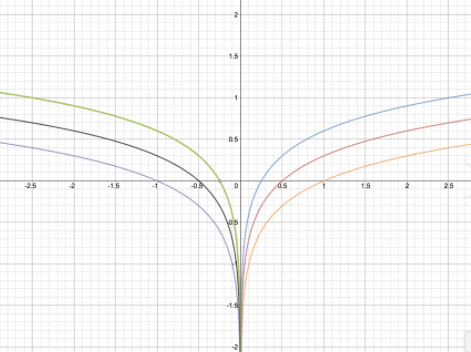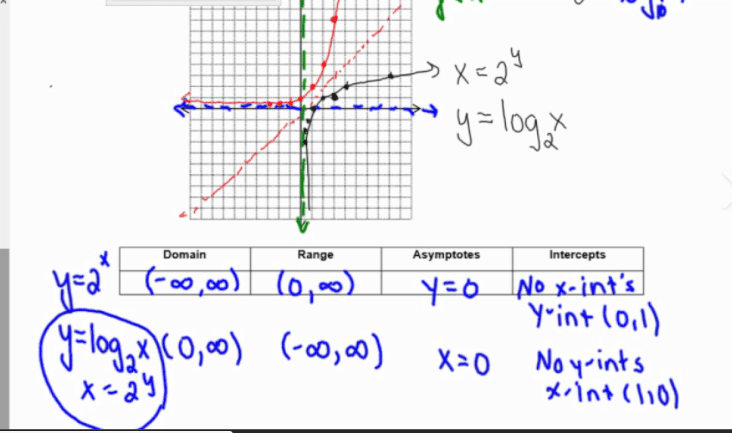
$8.4 \ln$ and $\log _{b}$
In this section, the inverse function of $x \rightarrow \exp (x)$ is considered.
Definition 8.4.1 $\ln$ is the inverse function of exp. Thus $\ln :(0, \infty) \rightarrow \mathbb{R}$, $\ln (\exp (x))=x$, and $\exp (\ln (x))=x$. The number e is that number such that $\ln (e)=1$.
By Corollary 7.10.2. it follows $\ln$ is differentiable. This makes possible the following simple theorem.
Theorem 8.4.2 The following basic properties are available for $\mathrm{ln}$.
$$
\ln ^{\prime}(x)=\frac{1}{x} .
$$
Also for all $x, y>0$,
$$
\begin{gathered}
\ln (x y)=\ln (x)+\ln (y) \
\ln (1)=0, \ln \left(x^{m}\right)=m \ln (x)
\end{gathered}
$$
for all $m$ an integer.
Proof: Since exp $(\ln (x))=x$ and $\ln ^{\prime}$ exists, it follows
$$
\begin{aligned}
x \ln ^{\prime}(x) &=\exp (\ln (x)) \ln ^{\prime}(x)=\exp ^{\prime}(\ln (x)) \ln ^{\prime}(x) \
&=\exp (\ln (x)) \ln ^{\prime}(x)=x \ln ^{\prime}(x)=1
\end{aligned}
$$
and this proves 8.13. Next consider 8.14.
$$
x y=\exp (\ln (x y)), \quad \exp (\ln (x)+\ln (y))=\exp (\ln (x)) \exp (\ln (y))=x y
$$
Since exp was shown to be 1-1, it follows $\ln (x y)=\ln (x)+\ln (y) .$ Next $\exp (0)=1$ and $\exp (\ln (1))=1$ so $\ln (1)=0$ again because exp is 1-1. Let $f(x)=\ln \left(x^{m}\right)-m \ln (x)$. Then $f(1)=\ln (1)-m \ln (1)=0 .$ Also, by the chain rule, $f^{\prime}(x)=\frac{1}{x^{m}} m x^{m-1}-m \frac{1}{x}=0$ and so $f(x)$ equals a constant. The constant can only be 0 because $f(1)=0$. This proves the last formula of $8.15$ and completes the proof of the theorem.
The last formula tells how to define $x^{\alpha}$ for any $x>0$ and $\alpha \in \mathbb{R}$. I want to stress that this is something new. Students are often deceived into thinking they know what $x^{\alpha}$ means for $\alpha$ a real number because they have a meaning for $\alpha$ an integer and with a little stretch for $\alpha$ a rational number. Such deception should never be tolerated in mathematics.
Definition 8.4.3 Define $x^{\alpha}$ for $x>0$ and $\alpha \in \mathbb{R}$ by the following formula.
$$
\ln \left(x^{\alpha}\right)=\alpha \ln (x) .
$$
In other words,
$$
x^{\alpha} \equiv \exp (\alpha \ln (x))
$$From Theorem $8.4 .2$ this new definition does not contradict the usual definition in the case where $\alpha$ is an integer.
From this definition, the following properties are obtained.
Proposition 8.4.4 For $x>0$ let $f(x)=x^{\alpha}$ where $\alpha \in \mathbb{R} .$ Then $f^{\prime}(x)=\alpha x^{\alpha-1} .$ Also $x^{\alpha+\beta}=x^{\alpha} x^{\beta}$ and $\left(x^{\alpha}\right)^{\beta}=x^{\alpha \beta}$.
Proof: First consider the claim about the sum of the exponents.
$$
\begin{aligned}
x^{\alpha+\beta} & \equiv \exp ((\alpha+\beta) \ln (x))=\exp (\alpha \ln (x)+\beta \ln (x)) \
&=\exp (\alpha \ln (x)) \exp (\beta \ln (x)) \equiv x^{\alpha} x^{\beta} \
\ln \left(\left(x^{\alpha}\right)^{\beta}\right) &=\beta \ln \left(x^{\alpha}\right)=\alpha \beta \ln (x), \ln \left(x^{\alpha \beta}\right)=\alpha \beta \ln (x)
\end{aligned}
$$
The claim about the derivative follows from the chain rule. $f(x)=\exp (\alpha \ln (x))$ and so
$$
f^{\prime}(x)=\exp (\alpha \ln (x)) \frac{\alpha}{x} \equiv \frac{\alpha}{x} x^{\alpha}=\alpha\left(x^{-1}\right) x^{\alpha}=\alpha x^{\alpha-1}
$$
Definition $8.4 .5$ Define $\log {b}$ for any $b>0, b \neq 1$ by $\log {b}(x) \equiv \frac{\ln (x)}{\ln (b)}$.
Proposition 8.4.6 The following hold for $\log _{b}(x)$.
- $b^{\log {b}(x)}=x, \log {b}\left(b^{x}\right)=x$.
- $\log {b}(x y)=\log {b}(x)+\log _{b}(y)$
- $\log {b}\left(x^{\alpha}\right)=\alpha \log {b}(x)$
Proof: $b^{\log {b}(x)} \equiv \exp \left(\ln (b) \log {b}(x)\right)=\exp \left(\ln (b) \frac{\ln (x)}{\ln (b)}\right)=\exp (\ln (x))=x$ and also $\log {b}\left(b^{x}\right)=\frac{\ln \left(b^{x}\right)}{\ln (b)}=\frac{x \ln (b)}{\ln (b)}=x$. This proves 1 . Now consider [2] $$ \log {b}(x y)=\frac{\ln (x y)}{\ln (b)}=\frac{\ln (x)}{\ln (b)}+\frac{\ln (y)}{\ln (b)}=\log {b}(x)+\log {b}(y) .
$$
Finally, $\log {b}\left(x^{\alpha}\right)=\frac{\ln \left(x^{\alpha}\right)}{\ln (b)}=\alpha \frac{\ln (x)}{\ln (b)}=\alpha \log {b}(x)$.
$8.5$ The Complex Exponential
What does $e^{i x}$ mean? Here $i^{2}=-1$. Recall the complex numbers are of the form $a+i b$ and are identified as points in the plane. For $f(x)=e^{i x}$, you would want
$$
f^{\prime \prime}(x)=i^{2} f(x)=-f(x)
$$
so $f^{\prime \prime}(x)+f(x)=0$. Also, you would want $f(0)=e^{0}=1, f^{\prime}(0)=i e^{0}=i$. One solution to these conditions is $f(x)=\cos (x)+i \sin (x)$. Is it the only solution? Suppose $g(x)$ is another solution. Consider $u(x)=f(x)-g(x)$. Then it follows
$$
u^{\prime \prime}(x)+u(x)=0, u(0)=0=u^{\prime}(0) .
$$
Thus both $\operatorname{Re} u$ and $\operatorname{Im} u$ solve the differential equation and 0 initial condition. By Lemma $8.3 .3$ both $\operatorname{Re} u$ and $\operatorname{Im} u$ are equal to 0 . Thus the above is the only solution. Recall by De’Moivre’s theorem
$$
(\cos x+i \sin x)^{n}=\cos (n x)+i \sin (n x)
$$

$8.4 \ln$ 和 $\log _{b}$
在本节中,考虑 $x \rightarrow \exp (x)$ 的反函数。
定义 8.4.1 $\ln$ 是 exp 的反函数。因此 $\ln :(0, \infty) \rightarrow \mathbb{R}$, $\ln (\exp (x))=x$ 和 $\exp (\ln (x))=x$。数字 e 是满足 $\ln (e)=1$ 的数字。
根据推论 7.10.2。它遵循 $\ln$ 是可微的。这使得以下简单定理成为可能。
定理 8.4.2 以下基本性质可用于 $\mathrm{ln}$。
$$
\ln ^{\prime}(x)=\frac{1}{x} 。
$$
同样对于所有 $x, y>0$,
$$
\开始{聚集}
\ln (x y)=\ln (x)+\ln (y) \
\ln (1)=0, \ln \left(x^{m}\right)=m \ln (x)
\结束{聚集}
$$
对于所有 $m$ 一个整数。
证明:由于 exp $(\ln (x))=x$ 且 $\ln ^{\prime}$ 存在,所以有
$$
\开始{对齐}
x \ln ^{\prime}(x) &=\exp (\ln (x)) \ln ^{\prime}(x)=\exp ^{\prime}(\ln (x)) \ln ^ {\素数}(x) \
&=\exp (\ln (x)) \ln ^{\prime}(x)=x \ln ^{\prime}(x)=1
\end{对齐}
$$
这证明了 8.13。接下来考虑 8.14。
$$
x y=\exp (\ln (x y)), \quad \exp (\ln (x)+\ln (y))=\exp (\ln (x)) \exp (\ln (y))=x y
$$
由于 exp 被证明是 1-1,它遵循 $\ln (xy)=\ln (x)+\ln (y) .$ 接下来 $\exp (0)=1$ 和 $\exp (\ln ( 1))=1$ 所以 $\ln (1)=0$ 再次因为 exp 是 1-1。令$f(x)=\ln \left(x^{m}\right)-m \ln(x)$。那么 $f(1)=\ln (1)-m \ln (1)=0 .$ 另外,根据链式法则,$f^{\prime}(x)=\frac{1}{x^{ m}} mx^{m-1}-m \frac{1}{x}=0$ 所以 $f(x)$ 等于一个常数。常数只能为 0,因为 $f(1)=0$。这样就证明了最后一个公式$8.15$,完成了定理的证明。
最后一个公式告诉如何为任何 $x>0$ 和 $\alpha \in \mathbb{R}$ 定义 $x^{\alpha}$。我想强调这是新事物。学生经常被欺骗以为他们知道 $x^{\alpha}$ 对 $\alpha$ 一个实数意味着什么,因为他们对 $\alpha$ 一个整数有一个含义,而对于一个有理数 $\alpha$ 有一点延伸数字。在数学中绝不应该容忍这种欺骗。
定义 8.4.3 定义 $x^{\alpha}$ 为 $x>0$ 和 $\alpha \in \mathbb{R}$ 由以下公式。
$$
\ln \left(x^{\alpha}\right)=\alpha \ln (x) 。
$$
换一种说法,
$$
x^{\alpha} \equiv \exp (\alpha \ln (x))
$$From Theorem $8.4 .2$ 这个新定义与 $\alpha$ 是整数的情况下的通常定义并不矛盾。
根据该定义,获得以下性质。
命题 8.4.4 对于 $x>0$ 令 $f(x)=x^{\alpha}$ 其中 $\alpha \in \mathbb{R} .$ 然后 $f^{\prime}(x)=\ alpha x^{\alpha-1} .$ 还有 $x^{\alpha+\beta}=x^{\alpha} x^{\beta}$ 和 $\left(x^{\alpha}\right)^ {\beta}=x^{\alpha \beta}$。
证明:首先考虑关于指数之和的主张。
$$
\开始{对齐}
x^{\alpha+\beta} & \equiv \exp ((\alpha+\beta) \ln (x))=\exp (\alpha \ln (x)+\beta \ln (x)) \
&=\exp (\alpha \ln (x)) \exp (\beta \ln (x)) \equiv x^{\alpha} x^{\beta} \
\ln \left(\left(x^{\alpha}\right)^{\beta}\right) &=\beta \ln \left(x^{\alpha}\right)=\alpha \beta \ln (x), \ln \left(x^{\alpha \beta}\right)=\alpha \beta \ln (x)
\end{对齐}
$$
关于导数的主张遵循链式法则。 $f(x)=\exp (\alpha \ln (x))$ 等等
$$
f^{\prime}(x)=\exp (\alpha \ln (x)) \frac{\alpha}{x} \equiv \frac{\alpha}{x} x^{\alpha}=\alpha \left(x^{-1}\right) x^{\alpha}=\alpha x^{\alpha-1}
$$
定义 $8.4 .5$ 定义 $\log {b}$ 为任何 $b>0, b \neq 1$ 由 $\log {b}(x) \equiv \frac{\ln (x)}{\ ln (b)}$。
命题 8.4.6 以下对 $\log_{b}(x)$ 成立。
- $b^{\log_{b}(x)}=x, \log_{b}\left(b^{x}\right)=x$。
2.$\log_{b}(xy)=\log_{b}(x)+\log_{b}(y)$ - $\log_{b}\left(x^{\alpha}\right)=\alpha\log_{b}(x)$
证明:$b^{\log {b}(x)} \equiv \exp \left(\ln (b) \log {b}(x)\right)=\exp \left(\ln (b) ) \frac{\ln (x)}{\ln (b)}\right)=\exp (\ln (x))=x$ 还有 $\log {b}\left(b^{x} \right)=\frac{\ln \left(b^{x}\right)}{\ln (b)}=\frac{x \ln (b)}{\ln (b)}=x$。这证明了 1 。 现在考虑 [2] $$ \log {b}(xy)=\frac{\ln (xy)}{\ln (b)}=\frac{\ln (x)}{\ln (b)}+\frac{\ln ( y)}{\ln (b)}=\log {b}(x)+\log {b}(y) 。
$$
最后,$\log {b}\left(x^{\alpha}\right)=\frac{\ln \left(x^{\alpha}\right)}{\ln (b)}=\alpha \frac{\ln (x)}{\ln (b)}=\alpha \log{b}(x)$。
$8.5$ 复数指数
$e^{i x}$ 是什么意思?这里$i^{2}=-1$。回想一下复数的形式是 $a+i b$ 并且被标识为平面中的点。对于 $f(x)=e^{i x}$,你会想要
$$
f^{\prime \prime}(x)=i^{2} f(x)=-f(x)
$$
所以$f^{\prime \prime}(x)+f(x)=0$。另外,你会想要 $f(0)=e^{0}=1, f^{\prime}(0)=i e^{0}=i$。这些条件的一种解决方案是 $f(x)=\cos (x)+i \sin (x)$。它是唯一的解决方案吗?假设 $g(x)$ 是另一种解决方案。考虑 $u(x)=f(x)-g(x)$。然后紧随其后
$$
u^{\prime \prime}(x)+u(x)=0, u(0)=0=u^{\prime}(0) 。
$$
因此 $\operatorname{Re} u$ 和 $\operatorname{Im} u$ 都求解微分方程和 0 初始条件。根据引理 $8.3 .3$ , $\operatorname{Re} u$ 和 $\operatorname{Im} u$ 都等于 0 。因此,以上是唯一的解决方案。由 De’Moivre 定理回忆
$$
(\cos x+i \sin x)^{n}=\c

微积分note Integer Multiples of Irrational Numbers 请认准UprivateTA™. UprivateTA™为您的留学生涯保驾护航。